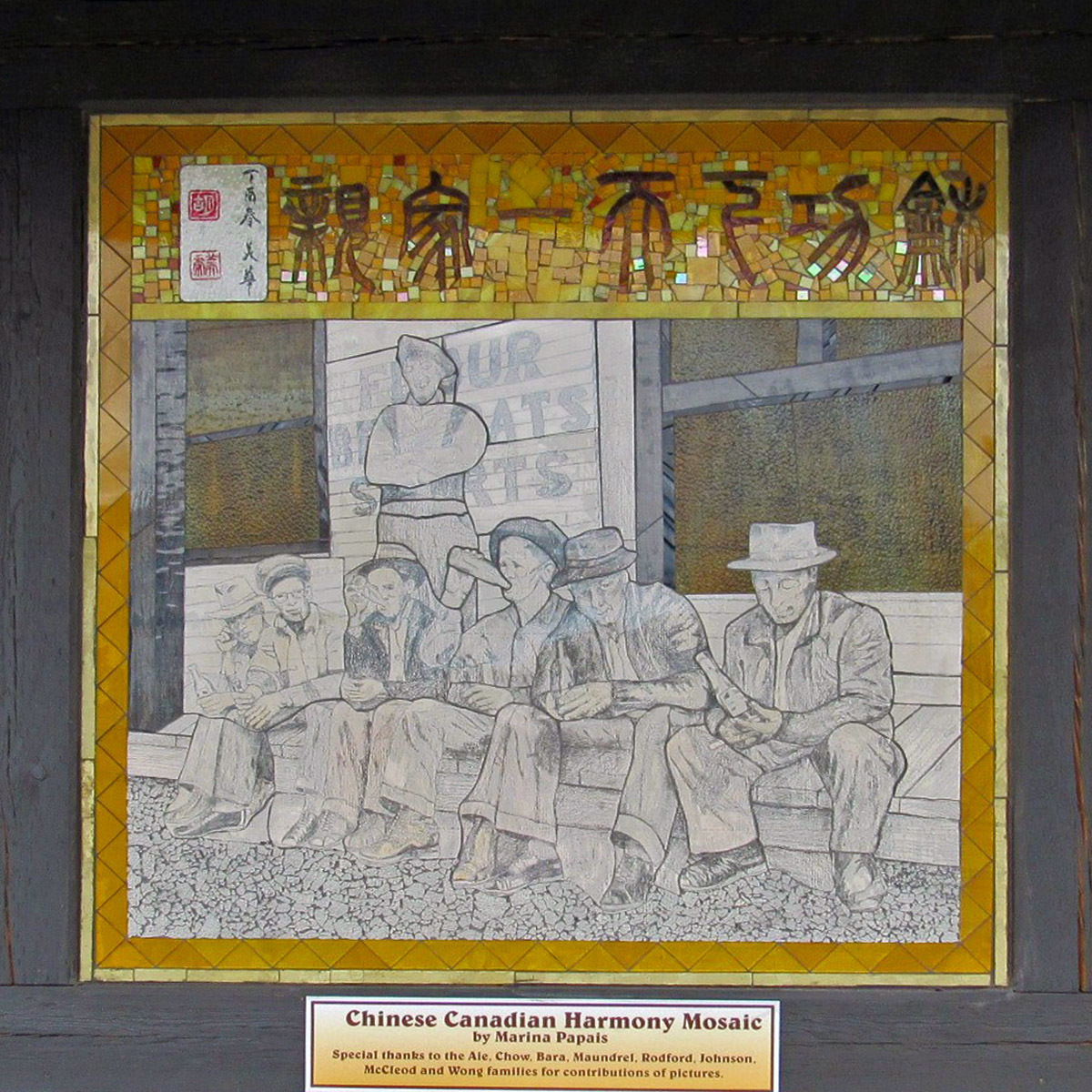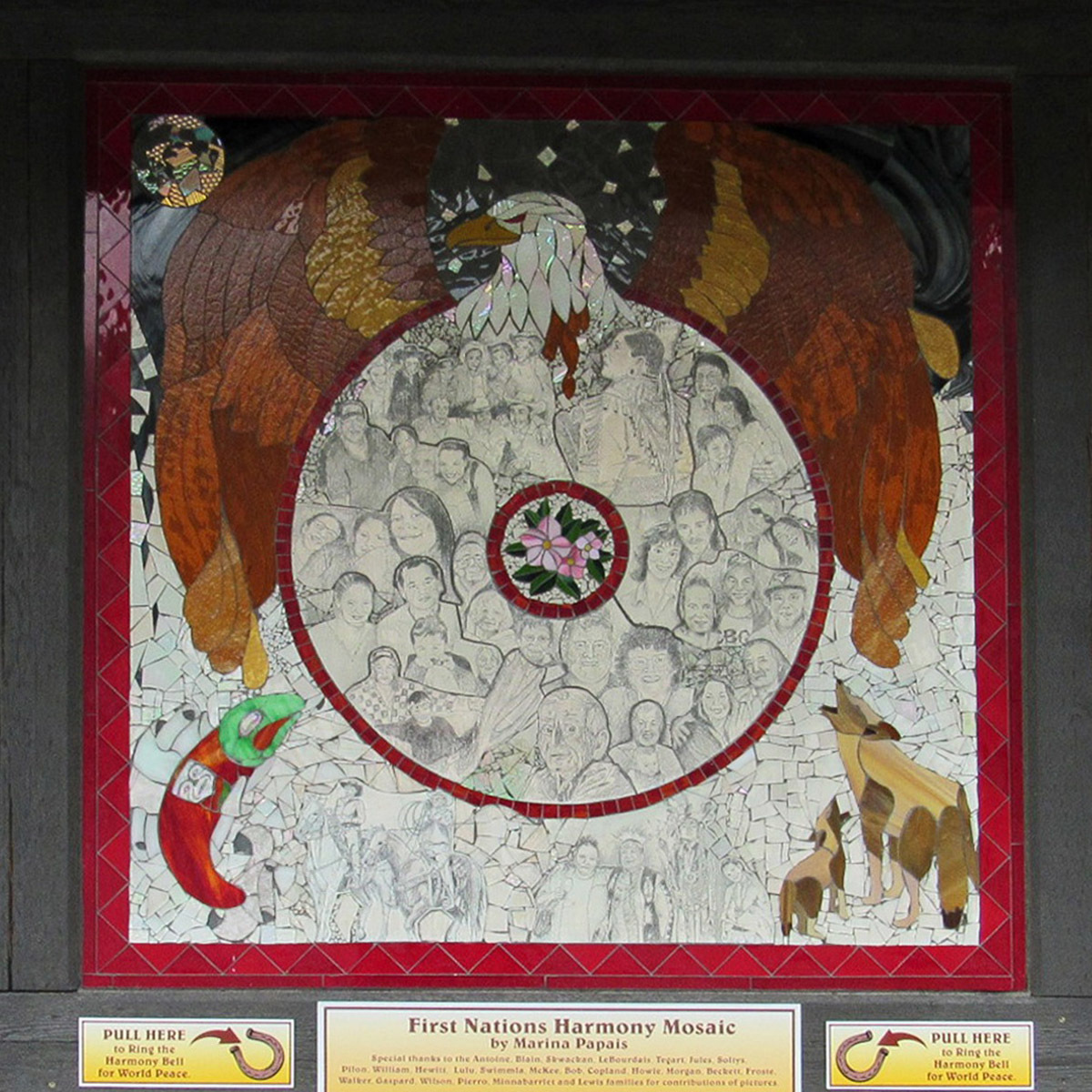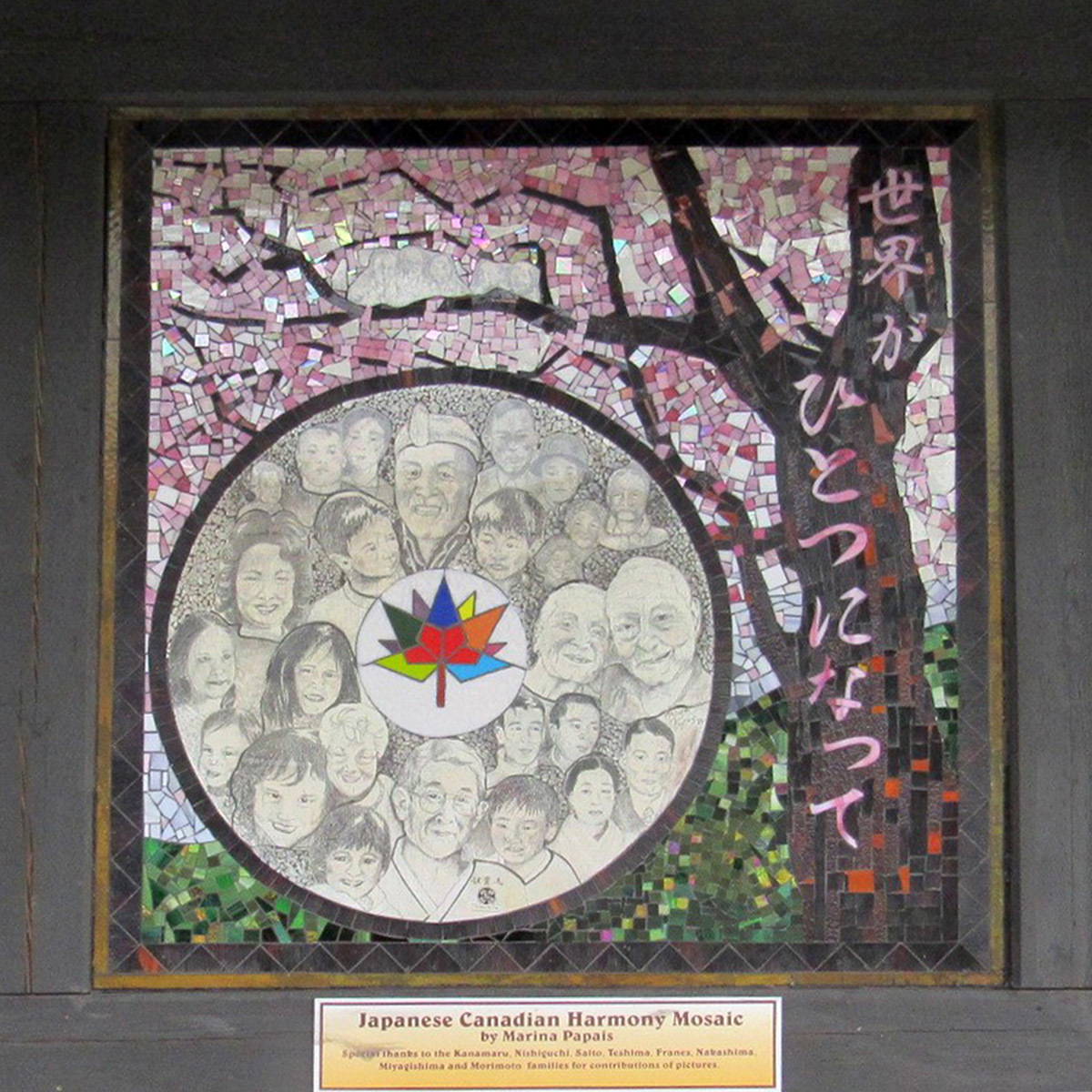Harmony Bell Tower Structure and Glass Mosaic Art
Designed by Daniel Collett the structure is 21 feet 6 inches high and houses the harmony bell and four glass mosaic art panels aligned to NSEW compass directions.
Each panel created by artist Marina Papais, is broadly intended to represent peoples of the world. The panels created in collaboration with individuals, groups and families from our community, are meant to express their idea of community as it relates to world harmony. Their stories, as interpreted through art may enlighten us to reasons for historical resentments and, moreover, lead us to a process of reconciliation towards peace and harmony in our communities, and ultimately the world.
The harmony bell, generously donated by Kevin and Muriel Scallon, was given to them by a neighbor cleaning out their basement in Ashcroft. While the bell's history is unclear, its current home welcomes visitors to ring the bell for world peace and harmony.
Acknowledgments
The Rotary and Lions Clubs of our community gratefully acknowledge and thank the following groups and individuals:
New Pathways to Gold Society for their vision and support for reconciliation and for funding this project.
The Village of Ashcroft, Mayor and Council, together with their administration and work crews for their support, planning, and foundation preparation.
The Ashcroft Indian Band and Chief Greg Blain for their support and approval of this project.
The Ashcroft Museum for providing historical context and pictures for the Harmony Mosaics.
The Harmony structure crew of Bruce Walker, Pache Denis, Alex Lepore, Chuck Winslow and Josh Granitto, led by Daniet Collett.
transcribed from sign
The Harmony Bell Tower was Dedicated in June 2018, it is a favorite designation for visitors from around the world. Everyone is welcome to ring the Harmony Bell for world peace. There are four panels featured on the Harmony Bell Tower. Each representing the unique diversity of the area.
Chinese Canadian Harmony Mosaic
by Marina Papais

The Chinese Canadian Harmony Mosaic has colorful individual tiles incorporated in the panel across the top with Chinese letters, possibly symbols.
Chinese immigration to Canada dates back pre-1800. The Chinese immigration increased dramatically during the Fraser Gold Rush of 1858.
While gold diminished, many Chinese made their way to Ashcroft and surrounding communities, helped build the towns and establishing businesses, produce production in local fields and ranching that helped the local communities.
First Nations Harmony Mosaic
by Marina Papais
Special thanks to the Aie, Chow, Bara, Maundrel, Rodford, Johnson, McCleod and Wong families for contributions of pictures.

The First Nations Harmony Mosaic has colorful individual tiles incorporated in the panel including the colorful fish and coyote that are in the lower section surrounding that portion of the drawings. The large central eagle is the main focus.
Indigenous people have been living in the area since time immemorial.
The local nations include the Nlaka’pamux Nation,
part of the First Nations of Ashcroft Indian Band. Around the mid-1800s, the Nlaka’pamux people became involved in the European fur trade. The influx of Europeans to the are changed their nomadic lifestyle forever.
Japanese Canadian Harmony Mosaic
by Marina Papais
Special thanks to the Antoine. Blain, Skwackan, LeBourdais, Tegart, Jules, Softy's, PiIon, William, Hewitt, Lulu, Swimmla, McKee, Bob, Copland, Howie. Morgan, Beckett, Froste, Walker, Gaspard, Wilson, Pierro, Minnabarriet and Lewis families for contributions of pictures.

Japanese Canadian Harmony Mosaic has colorful individual tiles incorporated in the panel with one of the predominant features are the happy faces of the people in the center.
On the left side is a Cherry Tree with cherry blossoms are represented by the small pink tiles surrounding most of the tree branches.
In Japanese art the symbolic Cherry Tree with falling blossoms is often used and is the symbol of spring, time of renewal, and the fleeting nature of life. The Cherry blossoms life cycle is very short with the blooms peaking around two weeks, and the blossoms start to fall.
During this season in Japan, people like to have cherry blossom parties with colleagues, friends, and family. A cherry
blossom makes people merry.
There is a symbol in the center representing Canada 150th anniversary celebrated in 2017.
Canadian Settlers Harmony Mosaic
by Marina Papais
Special thanks to the Kanamaru, Nishiguchi, Saito, Teshima, Franes, Nakashima. Miyagishima and Morimoto families for contributions of pictures.

Canadian Settlers Harmony Mosaic has colorful individual tiles incorporated in the panel with one of the predominant features are the pictures of some of the early settlers in the area.
Canadian Settlers Harmony Mosaic has at the center a wagon wheel, which indicated most traveled by wagons across rugged mountain terrain and crossing raging rivers
as they made their way west. There are beautiful flowers diangular across two sections. There is a ranch scene in the upper right corner and in the other corner are settlers taking a leisurely ride across the bottomland.
Around the mid-1800s, the Nlaka’pamux people became involved in the European fur trade. The first settlers of European descent arrived in 1859, naming Ashcroft for their home in England, Ashcroft Manor. The community served as a transportation hub in the 1800s. The area served as Mile 0 for the road to the Cariboo goldfields and the BC Express Company was based here.
Special thanks to the Parke, Bryson, Schubert, Nesbitt, Barnes, Cornwall. Kirkpatrick, McAbee. Cataline, Stuart, Evans, Huston, Kidder and Tuohey families, and the Hare Krishna Community from Saranagati in Venables Valley for contributions of pictures.
Harmony Bell is waiting
to ring for world peace
Ashcroft's newest artwork sprang from the community.
BARBARA RODEN Jun. 19, 2018
It began with the gift of a bell, given by Ashcroft residents Kevin and Muriel Scallon to artist Marina Papais and her husband Daniel Collett.
The bell was intended as a personal gift, but Papais says that she had a dream that made her realize the bell was destined for something else.
“Within one week I woke up and had a dream that there was a sign on the highway saying, ‘Come to Ashcroft to ring the Harmony Bell for world peace.’ And I realized that the bell was not for us; it was for the project.”
Papais is referring to what has become known as the Harmony Bell project. After several years of planning, preparation, and work, the project—located at the south end of the Heritage Park on Railway Avenue in Ashcroft—will be unveiled at a ceremony on Saturday, June 23 to which all members of the community and surrounding area are invited.
“We can’t ripple the whole world, but we can start with our tiny community, begin the ripple here, and start something big,” says Papais.
“I told Daniel that we couldn’t keep the bell; that it was meant for the community.”
She began considering what form the project would take, and eventually decided on four large glass mosaics, each one depicting a different group of people who had been instrumental in building the town: First Nations, settlers, Chinese, and Japanese.
“It was super easy. Harmony means community, and I spent a lot of time reading about the history of Ashcroft and who built it.
“But the whole project grew out of the community. I didn’t shape it; the community did.”
Papais asked local residents for assistance in developing each of the mosaics, and received an overwhelming response, with people only too happy to send in photographs and tell stories. She lived on-reserve for several years, and understood the importance of the sacred circle, so used the four colours of the sacred circle in the artwork, with red for First Nations, white for European settlers, yellow for Chinese, and black for Japanese.
People came to realize what Papais was doing and why and worked with her to shape the mosaics. “Once they educated me, I understood what they wanted. It needed to be their voice. Japanese-Canadians brought me a picture of cherry blossoms and said, ‘This is what we want.’ First Nations people said that the coyote was an important figure for them.
“I was in touch with [long-time Hat Creek area ranchers] the Parke family, and Brian Parke said he’d like to see a wagon wheel in the middle [of the settlers mosaic] because ‘That’s how we got here.’ And there are hard-working hands in the piece.
‘The community led the project; I followed where they led me.”
It has been nearly three years since Papais and Collett received the bell, and Papais says that the project has changed and evolved a lot during that time.
“We went to the Village of Ashcroft and said we wanted to do this. Initially we wanted it near the bridge, but that didn’t work.” A site near the gazebo at the Heritage Park was settled on, with plans for paving stones, benches, and landscaping around the finished project.
It was not until the Ashcroft HUB opened in the fall of 2015 that Papais and Collett had the space to open a large mosaic studio and invite community members in to work on mosaics. Collett worked on the design of the structure that would house the mosaics and the bell, while Papais, an architectural glass artist whose works can be seen all around Ashcroft—worked on the mosaics.
Source: BC Local News